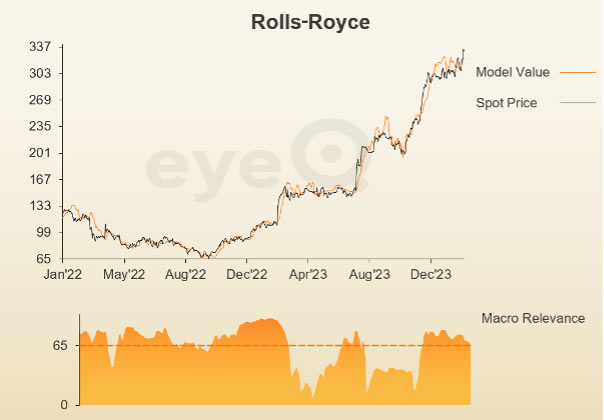eyeQ: Rolls-Royce shares – a case study in macro vs micro
interactive investor has teamed up with the experts at eyeQ who use artificial intelligence and their own smart machine to generate actionable trading signals. Here’s what it says about surging Rolls shares.
22nd February 2024 13:28
by Huw Roberts from eyeQ

"Our signals are crafted through macro-valuation, trend analysis, and meticulous back-testing. This combination ensures a comprehensive evaluation of an asset's value, market conditions, and historical performance." eyeQ
- Discover: eyeQ analysis explained | eyeQ: our smart machine in action | Glossary
Rolls-Royce
Trading signal: short-term tactical model
Model value: 327.79p
Fair Value Gap (premium/discount to Model Value): +7.98%
Model relevance: 62%
Data correct as at 22 February 2024. Please click glossary for explanation of terms.
UK company earnings keep coming thick and fast. From the eyeQ perspective, there are no clear trading signals on the UK banks. They are either being driven by bottom-up company news right now - HSBC Holdings (LSE:HSBA) and Barclays (LSE:BARC) don’t care about the big-picture stuff like economic growth and inflation at the moment.
Or, for Lloyds Banking Group (LSE:LLOY) and NatWest Group (LSE:NWG), macro does matter but, again, there’s no clear signal currently being identified by our smart machine. Their share prices are slightly elevated relative to where macro conditions say they should be. But the valuation gap (difference between our model value (fair value) and where the price currently is) isn’t yet big enough to trigger a trading signal.
Rolls-Royce Holdings (LSE:RR.) is an interesting story though.
Thursday’s annual results were strong – an almost-perfect combination of cost-cutting programmes bearing fruit, the return of long-haul travel, plus greater defence spending given events in Ukraine and the Middle East.
The subsequent rally is therefore justified from the perspective of company fundamentals – a micro viewpoint. From a macro perspective though, the super-positive reaction, at first glance, seems a bit of an overshoot. eyeQ’s model shows Rolls-Royce shares as 8% rich to overall macro conditions (the price is above our model value).
But this is a great example of why we include our macro relevance statistic in our analysis. This number simply captures whether the share price is being driven by big-picture macro drivers, or whether company fundamentals (known in industry jargon as “idiosyncratic” drivers) matter more.
In the bottom half of the chart below, the dashed orange line at 65% shows the threshold between the two. Above 65%, investors need to factor in macro’s influence on their decision-making process. Below 65% and you can park eyeQ for now, it’s all about your analysis of the company itself.
The point for Rolls is this: while, on this occasion, Rolls now looks somewhat rich from a top-down macro perspective, the bottom-up company news has been good, and that’s more important right now.

Source: eyeQ. Past performance is not a guide to future performance.
Useful terminology:
Model value
Where our smart machine calculates that any stock market index, singe stock or exchange-traded fund (ETF) should be priced (the fair value) given the overall macroeconomic environment.
Model (macro) relevance
How confident we are in the model value. The higher the number the better! Above 65% means the macro environment is critical, so any valuation signals carry strong weight. Below 65%, we deem that something other than macro is driving the price.
Fair Value Gap (FVG)
The difference between our model value (fair value) and where the price currently is. A positive Fair Value Gap means the security is above the model value, which we refer to as “rich”. A negative FVG means that it's cheap. The bigger the FVG, the bigger the dislocation and therefore a better entry level for trades.
Short Term model
This model looks at share prices over the last four months, captures the company’s relationship with growth, inflation, currency shifts, central bank policy etc and calculates our key results - model value, model relevance, Fair Value Gap. It’s what we call a tactical opportunity.
These third-party research articles are provided by eyeQ (Quant Insight). interactive investor does not make any representation as to the completeness, accuracy or timeliness of the information provided, nor do we accept any liability for any losses, costs, liabilities or expenses that may arise directly or indirectly from your use of, or reliance on, the information (except where we have acted negligently, fraudulently or in wilful default in relation to the production or distribution of the information).
The value of your investments may go down as well as up. You may not get back all the money that you invest.
Equity research is provided for information purposes only. Neither eyeQ (Quant Insight) nor interactive investor have considered your personal circumstances, and the information provided should not be considered a personal recommendation. If you are in any doubt as to the action you should take, please consult an authorised financial adviser.
Disclosure
We use a combination of fundamental and technical analysis in forming our view as to the valuation and prospects of an investment. Where relevant we have set out those particular matters we think are important in the above article, but further detail can be found here.
Please note that our article on this investment should not be considered to be a regular publication.
Details of all recommendations issued by ii during the previous 12-month period can be found here.
ii adheres to a strict code of conduct. Contributors may hold shares or have other interests in companies included in these portfolios, which could create a conflict of interests. Contributors intending to write about any financial instruments in which they have an interest are required to disclose such interest to ii and in the article itself. ii will at all times consider whether such interest impairs the objectivity of the recommendation.
In addition, individuals involved in the production of investment articles are subject to a personal account dealing restriction, which prevents them from placing a transaction in the specified instrument(s) for a period before and for five working days after such publication. This is to avoid personal interests conflicting with the interests of the recipients of those investment articles.